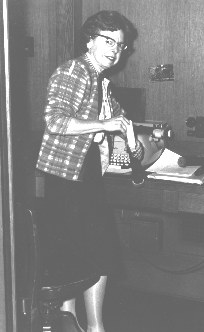Page 114
[Begin Tape 1, Side A]
Kasper: Well, we're here today with Charlotte Moulton who was a wire service reporter for the United Press from 1942 to 1978. Charlotte was also the Supreme Court reporter for the United Press from 1949 to 1978. So it was almost thirty years, isn't that right?
Moulton: Right. Yes it was.
Kasper: Yes. A long time. Charlotte, let's talk a little bit about your entry into journalism and about the fact that World War II was an opportunity for women to enter into journalism.
Moulton: Yes it was because the men were being drafted at the time that I went to United Press; some of them were volunteering also. So the men were leaving and they really needed women to run the show, so to speak. So women started to come into the business.
Kasper: And you started in 1942. You came down from Boston, isn't that right?
Moulton: No. Well, in 1940 I came down from Boston and I worked for the government for almost three years.
Kasper: But before coming to Washington, you'd worked on a small newspaper in Boston, is that right?
Moulton: Oh, a Methodist weeklyóa church paperóI was a secretary there and did what secretaries are supposed to do.
Kasper: Then, in 1942, when you went to work for the United Press, what kind of work were you doing with them?
Moulton: Oh, I was in the morgue. Do you know what a morgue is? It's a file room where they keep their newspaper clippings. Nobody had cleaned out the file roomó[Tape interruption.] The morgue is a place where they keep files that the desk men and other reporters can refer to when they're writing a story. That morgue hadn't been cleared out for quite a while and there were lots of things there that they really didn't need.

